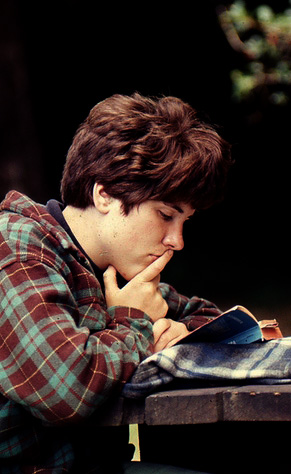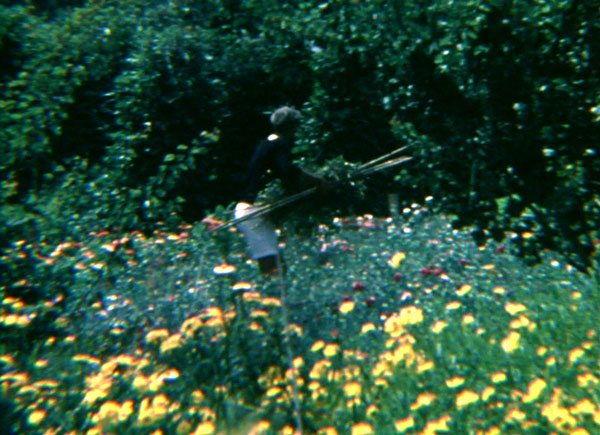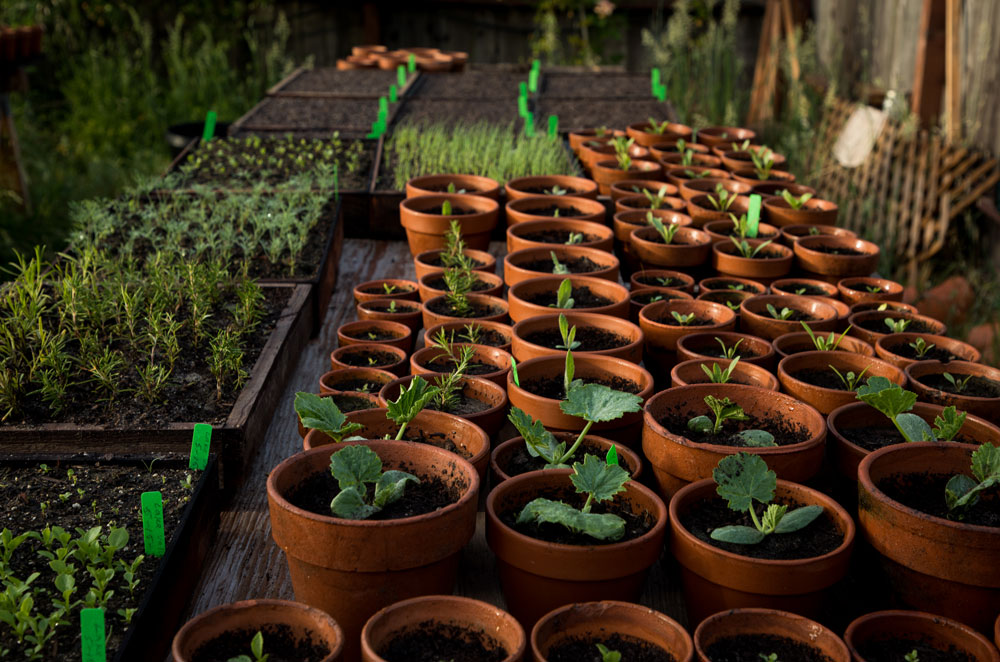Remembering Alan Chadwick
Alan Chadwick working near a carnation bed, Santa Cruz, 1971. Photo by Michael Stusser
To remember Chadwick, is to remember many of the best times and experiences of my life: my first taste of succulent Bibb lettuce, the golden glow of aromatic chamomile tea in flowerful china cups scrounged by Alan from thrift stores downtown, crunchy-sweet edible pod peas, hummers darting among the scarlet runner beans, doves coo-cooing their mating call, and around and through it all a lean tan man with a shock of steel-gray hair. A man who’s every word, glance, and movement was as enchanting as the garden itself. I loved the garden, but I stayed to enjoy and soak up the other skills of its creator.
What I loved about him most was that he expected nothing less from anyone than their best. Those who chose to stay and work with him stretched and grew to meet those standards and expectations.
My experience is that Chadwick very much enjoyed the contributions of women in the garden. Throughout the years I worked in the UCSC Garden Project—from fall 1967 until graduation in June 1970, there were always many women prominently working there. The summer of ’69, besides Beth Benjamin, there were Linda Jolly, Beth Padgett (Kaffka), Sherry (Slaughterov) Wildfeuer, Marcia, Stephanie and her sister Lily, myself, and several more who worked all day, every day, right alongside Jim Nelson, Steve Kaffka, Steve Decater, Greg Hudson, Michael Zander, Phil Johnson, Dan Maguire, Will David. The ratio of males to females seemed quite balanced.
I rarely asked for a job. I just joined others already doing what looked most interesting and learned from them. Sherry, Linda, Greg, Steve and many others were very patient, skilled teachers. I also made it a point to greet newcomers who looked uncertain, to show them how to do something specific, and to share in general what was going on in the garden.
Nancy and Beth say they wanted to prove they could work equally to the men. Alan never expected or demanded that. I concentrated on doing the work I liked best:
- Sowing seeds—“Concentrate on the edges, and the center will take care of itself”.
- Transplanting—“Space each plant so that leaves will cover the soil as it matures”—I loved the beauty of that honeycomb pattern!
- Harvesting—learning to gauge the precise peak for each vegetable and flower.
Early on, Alan entrusted me with something different. He was in despair that an unaware student had endangered the success of the entire seedling stock of Cineraria. Small seedlings had been carefully transplanted into pots of loose, airy soil, and then the unaware student had smashed the entire soil surface hard around the neck of each seedling, as I’ve since watched many a would-be gardener do: that last throat-smashing gesture of fatal affection and caring.
Cinerarias are a personal and almost universal favorite, a flower that dreams are made of, bouquet-wide heads of electric blues and magenta with a sprinkling of dusty corals and mauve.
I quickly found that Alan’s instructions to loosen the surface and hope for the best would not suffice. The plants were not only packed firm, the soil level was also too high, smothering the crown and certain to cause rot. So I developed my own method: fingers gently cupped around the crown, flip the entire pot upside down, loosen the top rootless soil plug off entirely, check remaining soil for correct depth and texture, and move on.
A few dozen pots later, Alan came back to check progress and he saw that I had changed his directions. His gaze was sharply concerned, but his questions were gentle: What was I doing? “Show me!” So I did. His only comment was to gently shift my hands with the inverted pot away from the plants below, where in my nervousness, I had been raining potting soil. Then he strode off with a confident flourish: “Carry on!”
Both the Cinerarias and I thrived.
Another day, Alan strode to meet me in agitation as I entered the garden. Could I take charge of two new students weeding the bank above Hagar Drive? He had assigned them the simplest, most error-safe job he could think of, an entry-level job for young children. He groaned, “If they can’t weed, what can they do?”
I joined those students and saw that Alan was correct, they were making a muddle of it. So we spent the rest of their time there weeding side-by-side, me showing them what to pull and what to leave, how to tease out large weeds without damaging the crop, how not to step on cultivated or amended soil. We laughed a lot and shared an enjoyable morning together.
I never thought about it consciously before, but Alan had assigned me a job as important as any other: to protect the garden from harm, yes, but more importantly, to grow gardeners. The garden bloomed and beckoned from the hill above Stevenson. Many were summoned and never wished to leave. If you look at what and who has grown from that place, you cannot doubt his skill and success. He was there to grow gardeners, and we have, since then, sprouted and multiplied many hundreds strong.
-- Phyllis Anderson

Phyllis Anderson in 1968


